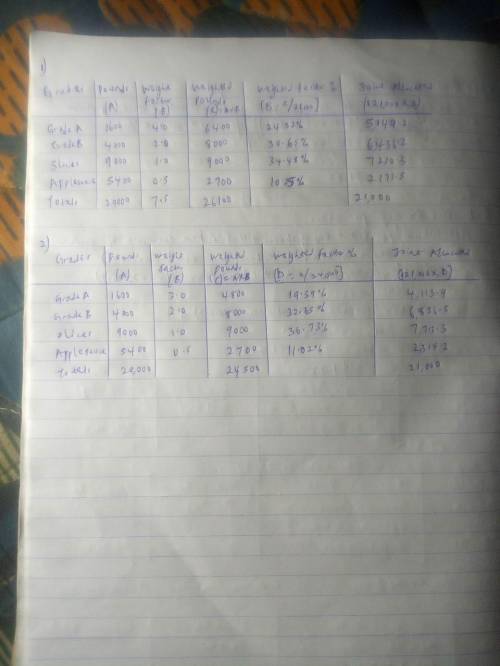
Business, 07.06.2020 05:02 herbal420medici
Allocating Joint Costs Using the Weighted Average Method Orchard Fresh, Inc., purchases apples from local orchards and sorts them into four categories. Grade A are large blemish-free apples that can be sold to gourmet fruit sellers. Grade B apples are smaller and may be slightly out of proportion. These are packed in boxes and sold to grocery stores. Apples for slices are even smaller than Grade B apples and have blemishes. Apples for applesauce are of lower grade than apples for slices, yet still suitable for canning. Information on a recent purchase of 20,000 pounds of apples is as follows: Assume that Orchard Fresh, Inc., uses the weighted average method of joint cost allocation and has assigned the following weights to the four grades of apples: Grades Pounds Weight Factor Grade A 1,600 4.0 Grade B 4,000 2.0 Slices 9,000 1.0 Applesauce 5,400 0.5 Total 20,000 Total joint cost is $21,000. Required: 1. Allocate the joint cost to the four grades of apples using the weighted average method. Round your allocation percentages to four decimal places and round the allocated costs to the nearest dollar. Joint Cost Grades Allocation Grade A $ 5,149.4253 Grade B Slices Applesauce Total $ (Note: The joint cost allocation does not equal $21,000 due to rounding.) 2. What if the factory found that Grade A apples were being valued less by customers and decided to decrease the weight factor for Grade A apples to 3.0

Answers: 3


Other questions on the subject: Business

Business, 22.06.2019 08:30, aasiarobinson998
What is the key to success in integrating both lethal and nonlethal activities during planning? including stakeholders once a comprehensive operational approach has been determined knowing the commander's decision making processes and "touch points" including stakeholders from the very beginning of the design and planning process including the liaison officers (lnos) in all the decision points?
Answers: 1



Business, 22.06.2019 21:10, leo4687
Match the terms with their correct definition. terms: 1. accounts receivable 2. other receivables 3 debtor 4. notes receivable 5. maturity date 6. creditor definitions: a. the party to a credit transaction who takes on an obligation/payable. b. the party who receives a receivable and will collect cash in the future. c. a written promise to pay a specified amount of money at a particular future date. d. the date when the note receivable is due. e. a miscellaneous category that includes any other type of receivable where there is a right to receive cash in the future. f. the right to receive cash in the future from customers for goods sold or for services performed.
Answers: 1
You know the right answer?
Allocating Joint Costs Using the Weighted Average Method Orchard Fresh, Inc., purchases apples from...
Questions in other subjects:


English, 27.07.2019 00:30



Mathematics, 27.07.2019 00:30





Advanced Placement (AP), 27.07.2019 00:30




